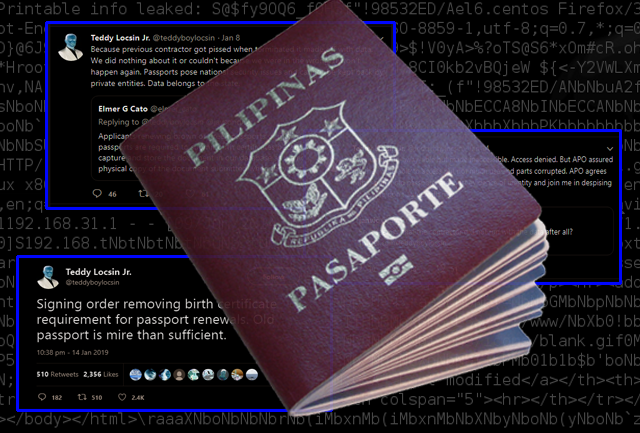Passport Data Mess: What’s the Real Problem?

ON JANUARY 8, Foreign Affairs Secretary Teodoro Locsin, Jr. tweeted that the Department of Foreign Affairs (DFA) is rebuilding its database from scratch because a former passport contractor “took all the data.” The tweet responded to a question asking why the current passport renewal process requires applicants to present their birth certificates together with their old passports.
Locsin explained in a series of tweets that
Everybody agrees with me that old passport is 1000% ID better than birth certificate: the holder applied for it and not someone else for a baby. But we are rebuilding our files from scratch because previous outsourced passport maker took all the data when contract terminated. https://t.co/cPjC3w7kAt
— Teddy Locsin Jr. (@teddyboylocsin) 8 January 2019
Media followed the passport hullabaloo, highlighting issues on data security.
ANC’s Headstart was among the first to report the clarification. Former Foreign Secretary Perfecto Yasay, in an interview with Karen Davila on January 14, said passport data are intact.
Yasay said Locsin’s tweet referred to the French company Francois-Charles Oberthur Fiduciaire (Oberthur). The former DFA secretary explained that per its contract, Oberthur had surrendered the database to the DFA and the Bangko Sentral ng Pilipinas (BSP). He said that Locsin might be misinformed and that his claim was “false” and “malicious.”
Locsin then retracted his claim and tweeted on January 14 that “data is not run-away-able but made inaccessible” and that the files may be corrupted. Yasay explained that this is because Oberthur and the current passport printer, United Graphics Expression Corporation (UGEC), might be using different systems.
Media also quoted DFA staff who clarified that birth certificate is required only for first-time applicants of machine-readable passports or the holders of old brown and green passports.
Also on January 14, Locsin tweeted that he signed the order “removing birth certificate requirement for passport renewals.”
All media organizations reported the clarification and the assurance that all data are safe.
Clearly, there is no data problem. And the DFA Secretary has only himself to blame for the hysteria. The media following Locsin’s tweets did not heap the blame on him, with the exception of some opinion pieces including commentary by Rosario Garcellano in the Philippine Daily Inquirer.
Pointing Out a Real Issue
The passport mess bared unresolved issues on passport contracting, which the media should have followed up to clarify the different responsibilities involved.
CMFR cheers TV5’s Aksyon for its report explaining in detail the problems in the recent passport mess. While other reports said that there was no data breach or that no data has been stolen, Aksyon took time to explain the problematic process that may have led to the controversy.
Aksyon explained the passport fiasco in an easy-to-understand explainer aired on January 14.
The news program recalled that in early 2000, when the International Civil Aviation Organization (ICAO) required all passports to be machine readable by 2010, BSP started printing blank passports in 2006 and contracted Oberthur to set up the system to input data. Oberthur’s contract ended in 2009. However, the French company assisted the DFA until 2015 free of charge.
The problem started in 2015 when the DFA transferred the contract to the government-owned corporation APO Printing. But APO, not having the capacity to create machine readable passports, subcontracted the job to the private firm, UGEC.
According to the explainer, the problem lies in the contract. APO was not allowed to subcontract to UGEC as of February 2017 when Malacanang declared this illegal. Anchor Ed Lingao said that it has been two years since, but the government has not done anything to address the problem. The explainer also noted that the passport is overpriced at PHP950.
With all of these unresolved issues out in the open, Aksyon then asked who should take responsibility, clearly a rhetorical question, as the answer seems obvious.
Leave a Reply